Panasonic KX-NS1000 User Manual

Operating Manual
Pure IP-PBX
Model No. KX-NS1000
Thank you for purchasing this Panasonic product.
Please read this manual carefully before using this product and save this manual for future use. In particular, be sure to read "1.1.1 For Your Safety (Page 14)" before using this product.
KX-NS1000: PCMPR Software File Version 004.22000 or later
Document Version 2015-06
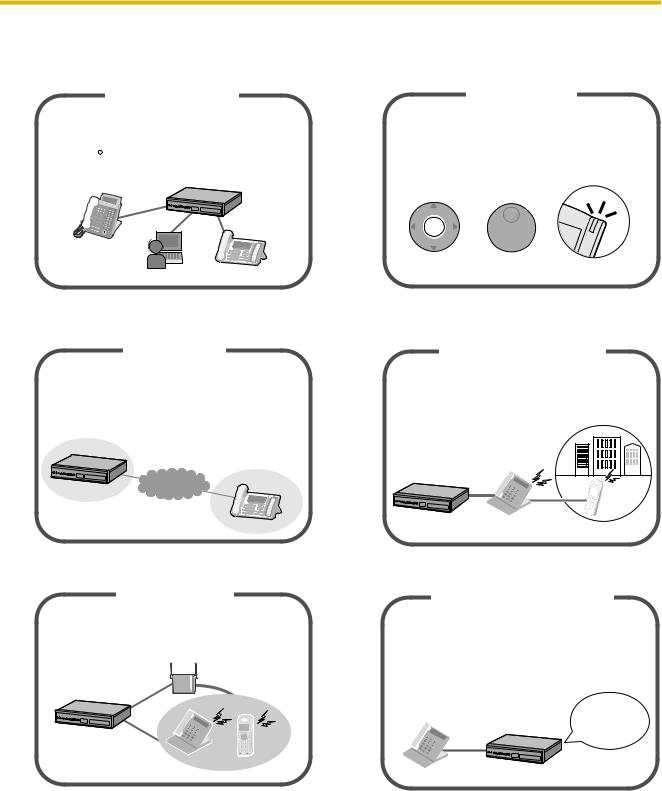
Feature Highlights
Feature Highlights
IP Communication
This PBX supports IP communication using
a variety of IP telephones, such as the KX-NT300/ KX-NT500 series with Self Labeling and/or Bluetooth R wireless headsets, Panasonic IP Softphones and SIP phones.
IP Proprietary
Telephone
IP Softphone |
SIP phone |
Consult your dealer
Remote Office
This PBX supports the use of SIP phones connected from a remote office over an IP network through an SBC (session border controller).
SIP phones can be set up by simply connecting the phones to the LAN at the remote office.
IP Network
Easy Operation
A Panasonic telephone that is equipped with a Navigator Key/Jog Dial and a display helps
you to access desired features easily. Also, you will be informed of the arrival of an incoming call or a message waiting by the lamp if it is equipped.
ENTER
Navigator Key |
Jog Dial |
Message/Ringer Lamp |
|
|
1.1 Before Operating the Telephones (Page 14)
Cellular Phone Features
This PBX supports the use of cellular phones with the PBX. Cellular phones can make and receive calls as if they were registered extensions.
Consult your dealer
Wireless System
This PBX optionally supports a Portable Station (PS) system. PSs can be used in the PBX with other wired telephones.
1.5 Cellular Phone Features (Page 174)
Built-in Unified Messaging
You can set incoming calls to be redirected to your mailbox to let callers leave voice messages when you are unable to answer the phone. You can access your mailbox to listen to the messages when you are away from the
office as well.
Hello, this
is John Smith. Please leave your message.
1.3.78 Wireless XDP Parallel Mode (Page 160) |
1.6 Unified Messaging Features (Page 178) |
2 |
Operating Manual |
Document Version 2015-06 |
|
|
|
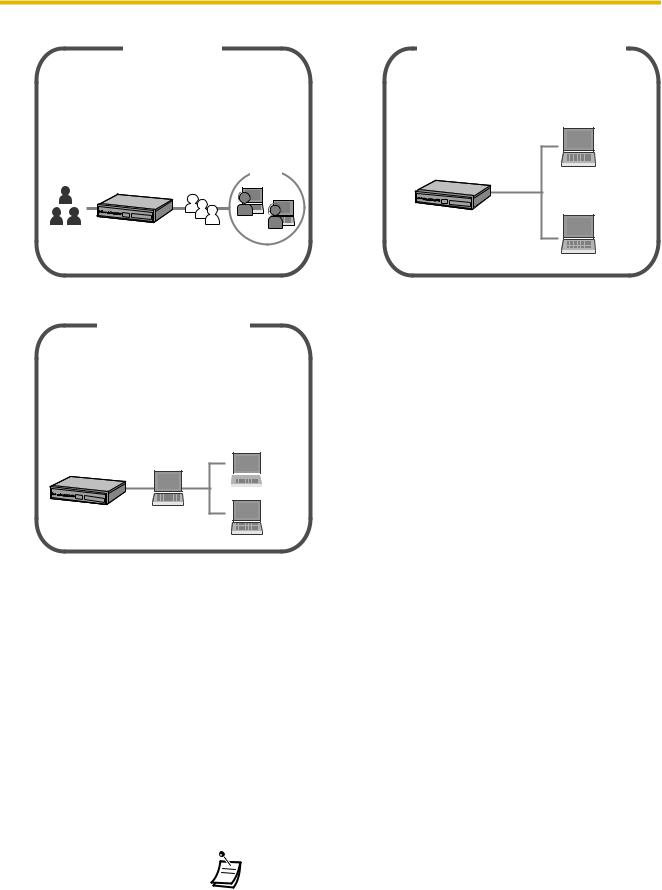
Feature Highlights
Call Center
This PBX offers a built-in Call Center feature called Incoming Call Distribution (ICD) Group. Incoming calls to an ICD Group can be queued or redirected to a preprogrammed destination, answered in order of priority and monitored by a supervisor extension.
ICD Group
Customers |
Queuing |
1.3.36 ICD GROUP FEATURES (Page 111)
CA Call Accounting
Communication Assistant (CA)
CA Client users can connect to the PBX without using an external server. CA Client users can make calls by clicking in a phonebook on their PC, as well as use many other features.
PC (Client)
PC (Client)
Consult your dealer
This application can calculate call cost estimates and track call activity for calls that are made through the PBX. Installing the CA Call Accounting web server software allows you to access CA Call Accounting from any PC by using a web client. You can sort and view, print, or export call information with the web client. In addition, reports can be
created based on exported data.
PC
 (Client)
(Client)
PC |
PC |
|
(Client) |
||
(Web Server) |
||
|
Consult your dealer
In This Manual,
•The following abbreviations are used: APT ® Analog Proprietary Telephone
Display PT ® Proprietary Telephone with a Display DPT ® Digital Proprietary Telephone
IP-PT ® IP Proprietary Telephone PS ® Portable Station
P-SIP ® Panasonic SIP Phone (KX-HDV series/KX-TGP600) PT ® Proprietary Telephone
SIP extension/SIP Extn. ® Extensions of the PBX which uses Session Initiation Protocol for communication.
SLT ® Single Line Telephone
•"PT" is used as a generic term to represent IP-PT, DPT, APT and Display PT.
•The following icons are used frequently.
!! Hints |
Conditions |
Document Version 2015-06 |
Operating Manual |
3 |
|
|
|

Feature Highlights
Notice
•This PBX supports SIP (Session Initiation Protocol) phones. However, some PBX features may not be available for SIP phones, depending on your telephone type.
•Under power failure conditions, the connected telephones may not operate. Please ensure that a separate telephone, not dependent on local power, is available for emergency use.
•Prior to connection of this product, please verify that the intended operating environment is supported. Satisfactory performance cannot be guaranteed for the following:
–interoperability and compatibility with all devices and systems connected to this product
–proper operation and compatibility with services provided by telecommunications companies over connected networks
NOTES
•Some optional hardware, software, and features are not available in some areas, or for some PBX models. Please consult your certified Panasonic dealer for more information.
•This manual provides basic information on how you can access commonly used PBX functions with proprietary telephones (PTs), single line telephones (SLTs), portable stations (PSs), SIP phones, and DSS Consoles. For detailed information about each feature or setting, refer to the Feature Manual or PC Programming Manual.
•In this manual, several kinds of PTs appear, as follows:
–IP Proprietary Telephone (IP-PT)
–Digital Proprietary Telephone (DPT)
–Analog Proprietary Telephone (APT)
–Proprietary Telephone with a Display (Display PT)
"PT" is used as a generic term to represent all of these PTs. If a PBX feature only supports specific PTs, such as IP-PTs, the available telephone types are clearly indicated.
•IP-PTs/SIP extensions may become busy and you may not be able to make or receive calls, depending on the network status.
•The contents of this manual apply to PBXs with a certain software version, as indicated on the cover of this manual. To confirm the software version of your PBX, refer to the PC Programming Manual.
•Product specifications are subject to change without notice.
•The preset melodies in this product are used with permission of © 2010 Copyrights Vision Inc.
•In this manual P-SIP phones are treated as non-KX-UT series SIP phones.
Notes for SIP Phone Users
Before using a SIP phone, please read the following notes.
For All SIP phone users
A tone may not be heard during an operation depending on the type of SIP phone being used. The following operation is an example.
4 |
Operating Manual |
Document Version 2015-06 |
|
|
|

Feature Highlights
[Example]
Account Code Entry
PT/SLT/PS/SIP Extn.
|
(Account) |
|
|
|
|
|
OR |
|
account code |
|
|
|
4 |
9 |
|
|
D.Tone |
|
|
|
|
||
Off-hook. |
Press Account or |
Enter account code |
Enter #. |
SIP phone users will |
|
|
enter 49. |
|
(max. 10 digits). |
|
|
not hear this tone.
outside phone no.
Dial outside phone number.
Seize a CO line before entering an outside phone number.
For KX-UT series SIP phone users
a.Operations that use feature numbers are limited. Also, flexible buttons are only available for certain KX-UT series SIP phone models. Refer to the telephone types displayed at the top left of each operation. However, for KX-UT series SIP phones, a tone may be heard depending on the system settings.
For details, consult your administrator.
b.A maximum of 32 digits can be input on a KX-UT series SIP phone at one time, including feature numbers, etc.
c.To execute certain operations, you may be required to press the ENTER button on a KX-UT series SIP phone during the operation.
The following 5 operations are examples.
[Examples]
Automatic Line Access
PT/SLT/PS/SIP Extn.
For KX-UT series:

 Press ENTER.
Press ENTER.
(L-CO) |
outside |
|
OR |
||
phone no. |
||
|
||
9 |
|
Off-hook. |
Press L-CO or |
Dial outside phone |
Talk. |
|
enter automatic |
number. |
|
|
line access number. |
|
|
Document Version 2015-06 |
Operating Manual |
5 |
|
|
|
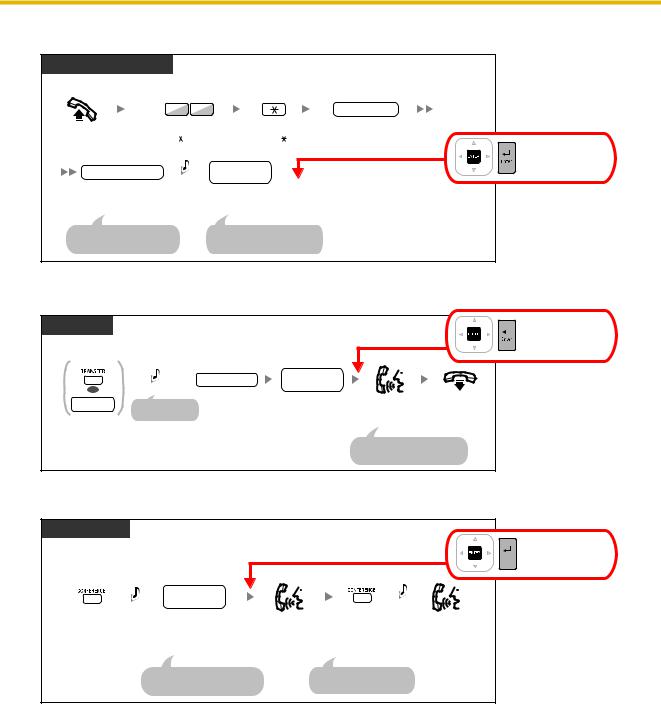
Feature Highlights
To call with a verification code
PT/SLT/PS/SIP Extn.
 4 7
4 7
Off-hook. |
Enter |
|
47. |
|
verification code PIN
C.Tone &
D.Tone
Enter verification code
PIN (max. 10 digits).
If a wrong verification code PIN is entered, you hear an alarm tone.
PIN: Personal Identification Number
|
verification code |
|
Enter . |
Enter verification code |
|
|
(max. 4 digits). |
For KX-UT series: |
desired |
|
Press ENTER. |
|
|
|
phone no. |
|
|
Dial desired |
|
|
phone number. |
|
|
Seize a CO line before entering an outside phone number.
To transfer to an outside party using the PBX service
SIP Extn.
During a conversation
|
CO line |
outside |
|
* |
|
|
|
||
|
phone no. |
|
|
|
|
C.Tone |
|
|
|
OR |
|
|
|
|
HOLD |
KX-UT series |
|
|
|
|
only. |
|
|
|
KX-UT series: |
Seize CO line. |
Dial outside phone |
Talk. |
On-hook. |
Press TRANSFER. |
|
number. |
This step can be omitted |
|
Other than KX-UT series: |
|
|
||
|
|
|
||
Press HOLD. |
(KX-UT series only). |
|
For KX-UT series: Press ENTER.
To establish a conference call
KX-UT series
During a conversation
|
desired |
|
phone no. |
C.Tone |
|
Press CONFERENCE. |
Dial desired phone |
|
number. |
|
Seize a CO line before dialing |
|
an outside phone number. |
|
C.Tone |
Talk to the |
Press CONFERENCE. Talk with multiple |
new party. |
parties. |
|
For KX-UT670: |
|
Press Start Conference. |
For KX-UT series: 
 Press ENTER.
Press ENTER.
6 |
Operating Manual |
Document Version 2015-06 |
|
|
|
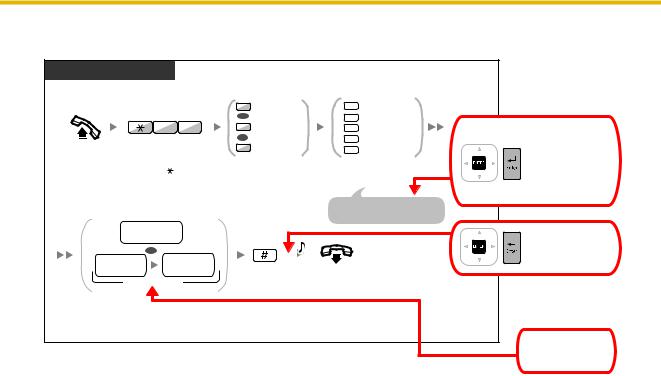
Feature Highlights
To set/cancel Call Forwarding
PT/SLT/PS/SIP Extn.
|
|
|
0 |
Both Calls |
0 |
Cancel |
|
|
|
|
OR |
|
2 |
All Calls |
|
|
7 |
1 |
1 |
Outside Calls |
3 |
Busy |
After entering 0 for "Cancel", |
|
|
|
OR |
|
4 |
No Answer |
|
|
|
|
|
|
|||
|
|
|
2 |
Intercom Calls |
5 |
Busy/No Answer |
for KX-UT series: |
|
|
|
|
|
|||
|
|
|
|
|
|
|
|
Off-hook. |
Enter |
71. |
Enter 0 to 2 as |
Enter required |
Press ENTER. |
||
|
|||||||
|
|
|
you desire. |
number. |
|
||
|
|
|
|
|
|
|
Go on-hook. |
|
|
|
|
|
For "Cancel", go on-hook |
|
|
|
|
|
|
|
directly after entering 0. |
|
|
|
destination |
|
|
|
|
|
|
|
extension no. |
|
|
|
|
For KX-UT series: |
|
|
OR |
|
|
|
|
|
Press ENTER. |
|
CO line |
outside |
|
C.Tone |
|
|
|
access no. |
phone no. |
|
|
|
|
||
|
|
|
|
|
|||
|
(max. 32 digits) |
|
|
|
|
|
|
Enter destination extension number. |
|
Enter #. |
On-hook. |
|
|
||
Or enter CO line access number |
|
|
|
|
|
||
and then outside phone number. |
|
|
|
|
|
||
For KX-UT series: max. 26 digits
For non-KX-UT series SIP phone users
a.The following features are available for SIP phone users:
–Making calls
–Answering calls
–Holding calls
–Transferring calls (You cannot go on-hook before the transferred party answers.)
b.The available operations using feature numbers are limited. Refer to the telephone types displayed at the top left of each operation.
c.The tones listed in "5.4.1 Tone" are not available for SIP phone users. Tones or the tone types may vary depending on the type of telephone being used. For example, when you put a call on hold, a specific tone for the SIP phone may be heard, or no tone may be heard.
d.Any number pressed while hearing a Busy/DND/Reorder tone, such as the feature number to activate Automatic Callback Busy, will be ignored.
e.The operations for SIP phones may differ from the steps in this manual, and may vary depending on the type of telephone being used.
f.To execute an operation, some SIP phones may require that the OK button is pressed after pressing all the buttons of the operation.
Notes for KX-NT300 Series, KX-NT500 Series, and KX-UT Series Users
If the primary PBX to which your telephone is connected fails, the extension may automatically switch its connection to a secondary PBX.
•The time required to switch to the secondary PBX or back to the primary PBX is different depending on the type of your telephone.
•When the extension switches its connection to the secondary PBX, your call will be disconnected if you are on a call.
•Even if the primary PBX becomes available again, your telephone will not reconnect to it if you are on a call.
Document Version 2015-06 |
Operating Manual |
7 |
|
|
|

Feature Highlights
•For KX-NT300 series and KX-NT500 series users, if background music (BGM) is being played through your telephone while it is connected to the secondary PBX, it will not reconnect to the primary PBX when it becomes available.
Notes for KX-NT543, KX-NT546, and KX-NT560 IP-PT Users
•While using a KX-NT543, KX-NT546, or KX-NT560 IP-PT in ECO mode, IP network transmission speed is relatively slow and the secondary Ethernet port cannot be used. To disable ECO mode, consult your dealer.
Trademarks
•Microsoft and Outlook are either registered trademarks or trademarks of Microsoft Corporation in the United States and/or other countries.
•The Bluetooth® word mark and logos are registered trademarks owned by Bluetooth SIG, Inc., and any use of such marks by Panasonic Corporation is under license.
•All other trademarks identified herein are the property of their respective owners.
•Microsoft product screen shot(s) reprinted with permission from Microsoft Corporation.
Open Source Software
This product uses Open Source Software. For details, click the Information button in Web Maintenance Console.
8 |
Operating Manual |
Document Version 2015-06 |
|
|
|

|
|
Table of Contents |
Table of Contents |
|
|
1 Operation ................................................................................................ |
13 |
|
1.1 |
Before Operating the Telephones ................................................................................. |
14 |
1.1.1 |
For Your Safety .............................................................................................................. |
14 |
1.1.2 |
Important Safety Instructions .......................................................................................... |
18 |
1.1.3 |
Precautions .................................................................................................................... |
19 |
1.1.4 |
Data Security .................................................................................................................. |
19 |
1.1.5 |
F.C.C. REQUIREMENTS AND RELEVANT INFORMATION ........................................ |
20 |
1.1.6 |
Before Operating the Telephones .................................................................................. |
22 |
1.2 |
Basic Operations ............................................................................................................. |
32 |
1.2.1 |
Making Calls ................................................................................................................... |
32 |
1.2.2 |
Answering Calls .............................................................................................................. |
34 |
1.3 |
Telephone Features and Operation ............................................................................... |
36 |
1.3.1 |
Absent Message ............................................................................................................. |
36 |
1.3.2 |
Account Code Entry ....................................................................................................... |
37 |
1.3.3 |
Alternate Calling—Ring/Voice ........................................................................................ |
38 |
1.3.4 |
Automatic Callback Busy (Camp-on) ............................................................................. |
38 |
1.3.5 |
BGM (Background Music) .............................................................................................. |
40 |
1.3.6 |
Call Hold ......................................................................................................................... |
40 |
1.3.7 |
Call Monitor .................................................................................................................... |
44 |
1.3.8 |
Call Park ......................................................................................................................... |
45 |
1.3.9 |
Call Pickup ..................................................................................................................... |
46 |
1.3.10 |
Call Splitting ................................................................................................................... |
48 |
1.3.11 |
Call Transfer ................................................................................................................... |
51 |
1.3.12 |
CALL WAITING FEATURES .......................................................................................... |
56 |
1.3.13 |
Call Waiting Tone ........................................................................................................... |
62 |
1.3.14 |
Character Entry .............................................................................................................. |
63 |
1.3.15 |
Conference ..................................................................................................................... |
66 |
1.3.16 |
Conference, Unattended ................................................................................................ |
71 |
1.3.17 |
Conference Group Call ................................................................................................... |
73 |
1.3.18 |
Data Line Security .......................................................................................................... |
79 |
1.3.19 |
DISA (Direct Inward System Access) ............................................................................. |
80 |
1.3.20 |
DND (Do Not Disturb) ..................................................................................................... |
83 |
1.3.21 |
Door Open ...................................................................................................................... |
86 |
1.3.22 |
Doorphone Call .............................................................................................................. |
87 |
1.3.23 |
EFA (External Feature Access) ...................................................................................... |
88 |
1.3.24 |
Executive Busy Override ................................................................................................ |
89 |
1.3.25 |
Extension Dial Lock ........................................................................................................ |
91 |
1.3.26 |
Extension Feature Clear ................................................................................................. |
92 |
1.3.27 |
Extension PIN (Personal Identification Number) ............................................................ |
93 |
1.3.28 |
External Relay ................................................................................................................ |
94 |
1.3.29 |
External Sensor .............................................................................................................. |
95 |
1.3.30 |
FWD (Call Forwarding) ................................................................................................... |
95 |
1.3.31 |
Hands-free Answerback ............................................................................................... |
104 |
1.3.32 |
Hands-free Operation ................................................................................................... |
105 |
1.3.33 |
Headset Operation ....................................................................................................... |
106 |
1.3.34 |
HOSPITALITY FEATURES .......................................................................................... |
109 |
1.3.35 |
Hot Line ........................................................................................................................ |
109 |
1.3.36 |
ICD GROUP FEATURES ............................................................................................. |
111 |
1.3.37 |
ICD Group Features—Call Log History for ICD Group ................................................. |
111 |
1.3.38 |
ICD Group Features—Incoming Call Queue Monitor ................................................... |
112 |
1.3.39 |
ICD Group Features—Log-in/Log-out .......................................................................... |
113 |
1.3.40 |
ICD Group Features—Log-in/Log-out Monitor and Remote Control ............................ |
116 |
Document Version 2015-06 |
Operating Manual |
9 |
|
|
|

Table of Contents
1.3.41 |
ICD Group Features—Manual Queue Redirection |
.......................................................118 |
1.3.42 |
ICD Group Features—Supervisory .............................................................................. |
118 |
1.3.43 |
Message Waiting .......................................................................................................... |
120 |
1.3.44 |
Mute ............................................................................................................................. |
123 |
1.3.45 |
Off-hook Monitor ........................................................................................................... |
124 |
1.3.46 |
OHCA (Off-hook Call Announcement) ......................................................................... |
124 |
1.3.47 |
One-numbered extension ............................................................................................. |
125 |
1.3.48 |
One-touch Dialing ......................................................................................................... |
126 |
1.3.49 |
Paging .......................................................................................................................... |
126 |
1.3.50 |
Paralleled Telephone ................................................................................................... |
129 |
1.3.51PDN (Primary Directory Number)/SDN (Secondary Directory Number)
|
Extension ...................................................................................................................... |
130 |
1.3.52 |
Printing Message .......................................................................................................... |
133 |
1.3.53 |
Privacy Release ........................................................................................................... |
134 |
1.3.54 |
Private Network Features—CLIP (Calling Line Identification Presentation) ................. |
134 |
1.3.55 |
Private Network Features—CLIR (Calling Line Identification Restriction) .................... |
135 |
1.3.56 |
Private Network Features—COLP (Connected Line Identification Presentation) ........ |
136 |
1.3.57 |
Private Network Features—COLR (Connected Line Identification Restriction) ........... |
136 |
1.3.58 |
Private Network Features—TIE Line Access ............................................................... |
137 |
1.3.59 |
Quick Dialing ................................................................................................................ |
138 |
1.3.60 |
Redial, Last Number ..................................................................................................... |
138 |
1.3.61 |
Room Status Control .................................................................................................... |
138 |
1.3.62Self Labeling (KX-NT366/KX-NT553/KX-NT556/KX-NT560/KX-UT248/KX-UT670
|
only) .............................................................................................................................. |
141 |
1.3.63 |
Speed Dialing, Personal ............................................................................................... |
143 |
1.3.64 |
Speed Dialing, System ................................................................................................. |
144 |
1.3.65 |
TAFAS (Trunk Answer From Any Station) ................................................................... |
145 |
1.3.66 |
Timed Reminder ........................................................................................................... |
145 |
1.3.67 |
Time Service ................................................................................................................ |
146 |
1.3.68 |
Verification Code Entry ................................................................................................. |
147 |
1.3.69 |
VOICE MAIL FEATURES ............................................................................................. |
148 |
1.3.70 |
Voice Mail Features—LCS (Live Call Screening) ......................................................... |
148 |
1.3.71 |
Voice Mail Features—Two-way Record ....................................................................... |
151 |
1.3.72 |
Voice Mail Features—Voice Mail Integration ............................................................... |
152 |
1.3.73 |
Wake-up Call ................................................................................................................ |
154 |
1.3.74 |
Walking COS ................................................................................................................ |
155 |
1.3.75 |
Walking Extension ........................................................................................................ |
156 |
1.3.76 |
Walking Extension, Enhanced ...................................................................................... |
157 |
1.3.77 |
Whisper OHCA ............................................................................................................. |
159 |
1.3.78 |
Wireless XDP Parallel Mode ........................................................................................ |
160 |
1.4 |
Display Features ........................................................................................................... |
161 |
1.4.1 |
Call Log, Incoming ........................................................................................................ |
161 |
1.4.2 |
Call Log, Outgoing ........................................................................................................ |
164 |
1.4.3 |
Directories .................................................................................................................... |
167 |
1.4.4 |
System Feature Access ............................................................................................... |
169 |
1.5 |
Cellular Phone Features ............................................................................................... |
174 |
1.5.1 |
Cellular Phone Features ............................................................................................... |
174 |
1.6 |
Unified Messaging Features ........................................................................................ |
178 |
1.6.1 |
What is the Unified Messaging system? ...................................................................... |
178 |
1.6.2 |
Logging in to and Configuring Your Mailbox ................................................................ |
179 |
1.6.3 |
Message Playback and Related Features .................................................................... |
189 |
1.6.4 |
Sending Messages ....................................................................................................... |
199 |
1.6.5 |
Transferring Calls ......................................................................................................... |
209 |
1.6.6 |
Other Features ............................................................................................................. |
217 |
1.6.7 |
Quick Reference ........................................................................................................... |
234 |
10 |
Operating Manual |
Document Version 2015-06 |
|
|
|

|
|
Table of Contents |
2 Manager Operation .............................................................................. |
237 |
|
2.1 |
Manager Service Features ............................................................................................ |
238 |
2.1.1 |
Dial Tone Transfer ........................................................................................................ |
238 |
2.1.2 |
External BGM (Background Music) .............................................................................. |
238 |
2.1.3 |
OGM (Outgoing Messages) ......................................................................................... |
239 |
2.1.4Private Network Features—NDSS (Network Direct Station Selection) Monitor
|
Release ........................................................................................................................ |
241 |
2.1.5 |
Remote Extension Dial Lock ........................................................................................ |
241 |
2.1.6 |
Time Service Mode Control .......................................................................................... |
242 |
2.2 |
Configuring Unified Messaging Features ................................................................... |
244 |
2.2.1 |
System Manager Features ........................................................................................... |
244 |
2.2.2 |
Message Manager Features ........................................................................................ |
257 |
3 Customizing Your Phone & System ................................................... |
275 |
|
3.1 |
Personal Programming ................................................................................................. |
276 |
3.1.1 |
Programming Information ............................................................................................. |
276 |
3.1.2 |
Personal Programming ................................................................................................. |
276 |
3.1.3 |
Programming Feature Clear ......................................................................................... |
285 |
3.1.4 |
Customizing the Buttons .............................................................................................. |
287 |
3.2 |
System Programming Using Web Maintenance Console ......................................... |
293 |
3.2.1 |
User Programming ....................................................................................................... |
293 |
4 Customizing Extensions and the System–for Managers ................. |
319 |
|
4.1 |
Manager Programming ................................................................................................. |
320 |
4.1.1 |
Programming Information ............................................................................................. |
320 |
4.1.2 |
Manager Programming ................................................................................................. |
320 |
4.1.3 |
Supervisory Monitor (ACD) Control .............................................................................. |
322 |
5 Appendix ............................................................................................... |
331 |
|
5.1 |
List of Operations by Telephone Type ........................................................................ |
332 |
5.1.1 |
List of Operations by Telephone Type ......................................................................... |
332 |
5.2 |
Troubleshooting ............................................................................................................ |
338 |
5.2.1 |
Troubleshooting ............................................................................................................ |
338 |
5.3 |
Feature Number Table .................................................................................................. |
341 |
5.3.1 |
Feature Number Table ................................................................................................. |
341 |
5.4 |
Tone ................................................................................................................................ |
349 |
5.4.1 |
Tone ............................................................................................................................. |
349 |
5.5 |
Revision History ............................................................................................................ |
353 |
5.5.1 |
PCMPR Software File Version 003.0xxxx .................................................................... |
353 |
5.5.2 |
PCMPR Software File Version 003.2xxxx .................................................................... |
355 |
5.5.3 |
PCMPR Software File Version 004.0xxxx .................................................................... |
357 |
5.5.4 |
PCMPR Software File Version 004.1xxxx .................................................................... |
358 |
5.5.5 |
PCMPR Software File Version 004.2xxxx .................................................................... |
359 |
Document Version 2015-06 |
Operating Manual |
11 |
|
|
|

Table of Contents
12 |
Operating Manual |
Document Version 2015-06 |
|
|
|

Section 1
Operation
This section shows you step by step how to use each feature. Read this chapter to become familiar with the many useful features of this PBX.
Document Version 2015-06 |
Operating Manual |
13 |
|
|
|
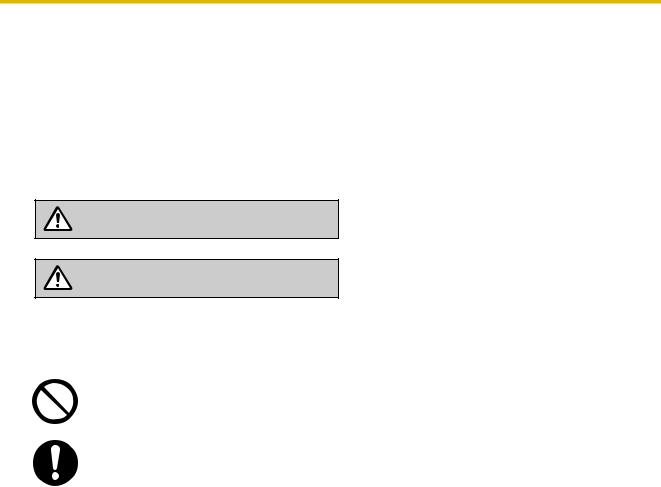
1.1.1 For Your Safety
1.1 Before Operating the Telephones
1.1.1 For Your Safety
To prevent personal injury and/or damage to property, be sure to observe the following safety precautions.
The following symbols classify and describe the level of hazard and injury caused when this unit is operated or handled improperly.
WARNING
CAUTION
This notice means that misuse could result in death or serious injury.
This notice means that misuse could result in injury or damage to property.
The following types of symbols are used to classify and describe the type of instructions to be observed.
This symbol is used to alert users to a specific operating procedure that must not be performed.
This symbol is used to alert users to a specific operating procedure that must be followed in order to operate the unit safely.
14 |
Operating Manual |
Document Version 2015-06 |
|
|
|
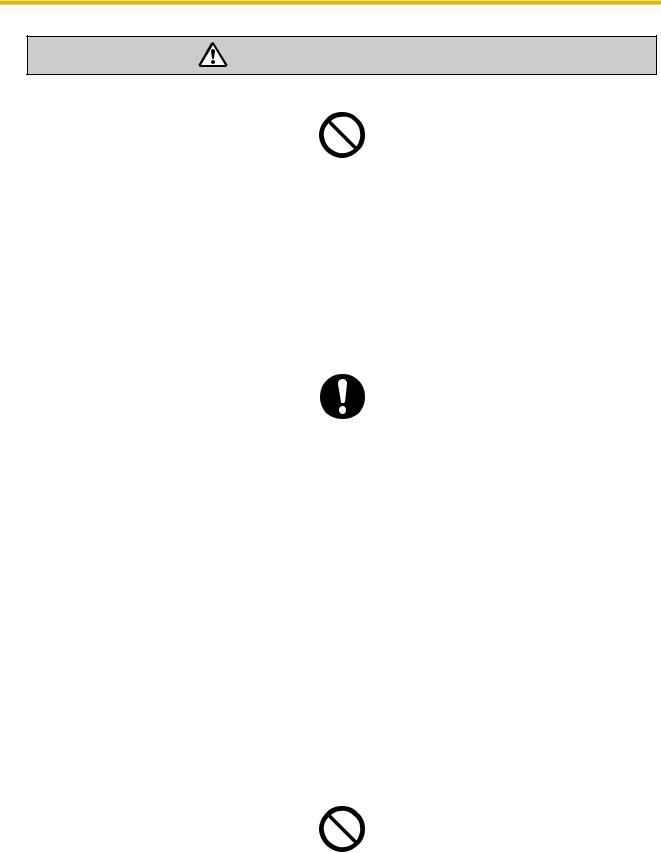
1.1.1 For Your Safety
WARNING
For All Telephone Equipment
•Do not allow rain to fall on the product or expose the product to moisture. Do not let water, oils, or other liquids to splash onto the product. Such conditions can lead to fire or electric shock, and may impair the performance of the product.
•Do not place the product on an unstable or uneven surface. If the product were to fall over, it may cause injury or damage to the product.
•Do not allow anything to rest on the power cord. Do not locate the product where the power cord may be stepped on or tripped on.
•Do not supply power to a combination of devices that exceeds the total rated capacity of the wall outlets or extension cables used. If outlets, power strips, extension cords, etc. are used in a manner that exceeds their rated capacity, they emit large amounts of heat, which could cause a fire.
•The product must only be installed and serviced by qualified service personnel. The product should be used as-is from the time of purchase; it should not be disassembled or modified. Disassembly or modification can cause a fire, electric shock, or damage to the product.
•Follow all warnings and instructions marked on the product.
•Products that require a power source should only be connected to the type of electrical power supply specified on the product label. If you are not sure of the type of power supply to your home, consult your dealer or local power company.
•For safety purposes some products are equipped with a grounded plug. If you do not have a grounded outlet, please have one installed. Do not bypass this safety feature by tampering with the plug.
•Regularly clean dust off of all equipment. Excessive amounts of dust can lead to fire or electric shock, and may impair the performance of the product.
•Unplug the product from the wall outlet and contact your dealer in the following cases:
a.When the power supply cord or plug is damaged or frayed.
b.If liquid has been spilled into the product.
c.If the product has been exposed to rain or water.
d.If the product does not operate according to the operating instructions. Adjust only the controls that are explained in the operating instructions. Improper adjustment of other controls may result in damage and may require service by a qualified technician to restore the product to normal operation.
e.If the product has been dropped or the cabinet has been damaged.
f.If product performance deteriorates.
For the PBX
•Do not insert foreign objects of any kind into this product, as they may touch dangerous voltage points or short out parts that could result in a fire or electric shock.
Document Version 2015-06 |
Operating Manual |
15 |
|
|
|

1.1.1For Your Safety
•Do not pull, bend, rest objects on, or chafe the power cord and plug. Damage to the power cord or plug can cause fire or electric shock.
•Do not attempt to repair the power cord or plug. If the power cord or plug is damaged or frayed, contact an authorized Panasonic Factory Service Center for a replacement.
•When mounting the PBX on a 19-inch rack, only use the 19-inch rack mounting equipment (attachment bracket, screws) included with the PBX.
•If damage to the unit exposes any internal parts, disconnect the power supply cord immediately and return the unit to your dealer.
•Unplug this unit from the AC outlet if it emits smoke, an abnormal smell or makes unusual noise. These conditions can cause fire or electric shock. Confirm that smoke has stopped and contact an authorized Panasonic Factory Service Center.
•This unit is equipped with a grounded plug. For safety reasons this plug must only be connected to a grounded outlet that has been installed according to applicable regulations.
•Plug the power cord firmly into an AC outlet. Otherwise, it can cause fire or electric shock.
16 |
Operating Manual |
Document Version 2015-06 |
|
|
|

1.1.1 For Your Safety
CAUTION
For All Telephone Equipment
•The product should be kept free of dust, moisture, high temperature (more than 40 °C [104 °F]), and vibration, and should not be exposed to direct sunlight.
•Unplug the product from the wall outlet before cleaning. Wipe the product with a soft cloth. Do not clean with abrasive powders or with chemical agents such as benzine or thinner. Do not use liquid cleaners or aerosol cleaners.
For the PBX
•To reduce the risk of fire, use only No.26 AWG or larger (e.g., 24 AWG) UL Listed or CSA Certified Telecommunication Line Cord.
•When relocating the equipment, first disconnect the telecom connection before disconnecting the power connection. When the unit is installed in the new location, reconnect the power first, and then reconnect the telecom connection.
•The power supply cord is used as the main disconnect device. Ensure that the AC outlet is located near the equipment and is easily accessible.
•Slots and openings in the front, back and bottom of the cabinet are provided for ventilation; to protect it from overheating, these openings must not be blocked or covered. The openings should never be blocked by placing the product on a bed, sofa, rug, or other similar surface while in use. The product should never be placed near or over a radiator or other heat source. This product should not be placed in a sealed environment unless proper ventilation is provided.
•When this product is no longer in use, make sure to detach it from the rack or wall.
•To protect this unit from static electricity, do not touch any external connectors of the unit.
Document Version 2015-06 |
Operating Manual |
17 |
|
|
|

1.1.2 Important Safety Instructions
Notice
For All Telephone Equipment
•Read and understand all instructions.
•When using a Panasonic proprietary telephone (PT), use only the correct Panasonic handset.
For the PBX
•Keep the unit away from heating appliances and devices that generate electrical noise such as fluorescent lamps, motors and televisions. These noise sources can interfere with the performance of the PBX.
•If you are having problems making calls to outside destinations, follow this procedure to test the CO lines:
1.Disconnect the PBX from all CO lines.
2.Connect known working single line telephones (SLTs) to those CO lines.
3.Make a call to an external destination using those SLTs.
If a call cannot be carried out correctly, there may be a problem with the CO line that the SLT is connected to. Contact your telephone company.
If all SLTs operate properly, there may be a problem with your PBX. Do not reconnect the PBX to the CO lines until it has been serviced by an authorized Panasonic Factory Service Center.
Note
For All Telephone Equipment
•Never attempt to insert wires, pins, etc. into the vents or holes of the product.
1.1.2Important Safety Instructions
When using your telephone equipment, basic safety precautions should always be followed to reduce the risk of fire, electric shock and injury to persons, including the following:
•Do not use the product near water, for example, near a bathtub, wash bowl, kitchen sink, or laundry tub, in a wet basement, or near a swimming pool.
•Avoid using wired telephones during an electrical storm. There is a remote risk of electric shock from lightning.
•Do not use a telephone in the vicinity of a gas leak to report the leak.
•Rack Mount Instructions—The following or similar rack-mount instructions are included with the installation instructions:
a.Elevated Operating Ambient—If installed in a closed or multi-unit rack assembly, the operating ambient temperature of the rack environment may be greater than room ambient. Therefore, consideration should be given to installing the equipment in an environment compatible with the maximum ambient temperature (Tma) specified by the manufacturer.
b.Reliable Earthing—Reliable earthing of rack-mounted equipment should be maintained. Particular attention should be given to supply connections other than direct connections to the branch circuit (e.g., use of power strips).
SAVE THESE INSTRUCTIONS
18 |
Operating Manual |
Document Version 2015-06 |
|
|
|
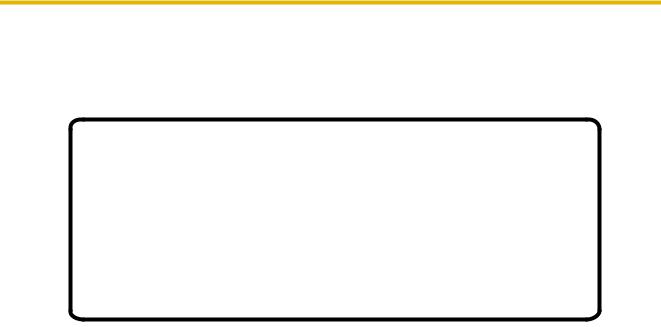
1.1.4 Data Security
1.1.3 Precautions
Notice for users in California
This product contains a CR coin cell lithium battery that
contains perchlorate material—special handling may apply.
See www.dtsc.ca.gov/hazardouswaste/perchlorate
1.1.4 Data Security
In order to use the PBX safely and correctly, the Security Requirements below must be observed. Failure to do so may result in:
•Loss, leakage, falsification or theft of user information.
•Illegal use of the PBX by a third party.
•Interference or suspension of service caused by a third party.
What is User Information?
User Information is defined as:
1.Information stored on the Storage Memory Card: System data, error data and activation key files.
2.Information sent from the PBX to a PC or a USB memory device:
System data, sound files for MOH (Music on Hold) and OGM (Outgoing Messages), and activation key files.
Requirements
1.The Storage Memory Card contains software for all the processes of the PBX and all the customer data. Therefore, do not allow unauthorized access to prevent data leakage.
2.Always make backups of data stored on the Storage Memory Card and/or perform regular system data backups to a USB memory device or a NAS. For details, consult your dealer.
3.To prevent illegal access from the Internet, activate a Firewall.
4.To avoid unauthorized access and possible abuse of the PBX, we strongly recommend:
a.Keeping the password secret.
b.Selecting a complex, random password that cannot be easily guessed.
c.Changing your password regularly.
5.Perform the following when sending the PBX for repair or handing it over to a third party.
a.Make a backup of data stored on the Storage Memory Card.
b.Using a formatter, format the Storage Memory Card so that information cannot be retrieved from it.
6.To prevent data leakage, render the Storage Memory Card physically unusable before disposal.
Document Version 2015-06 |
Operating Manual |
19 |
|
|
|

1.1.5F.C.C. REQUIREMENTS AND RELEVANT INFORMATION
7.When user information is sent from the PBX to a PC or a USB memory device, the confidentiality of that information becomes the responsibility of the customer. Before disposing of the PC or the USB memory device, ensure that data cannot be retrieved from it by formatting the hard disk and/or rendering it physically unusable.
1.1.5 F.C.C. REQUIREMENTS AND RELEVANT INFORMATION
1.Notification to the Telephone Company
This equipment complies with Part 68 of the FCC rules and the requirements adopted by the ACTA. On the side of this equipment is a label that contains, among other information, a product identifier in the format US: ACJIS04BKX-NS1000. If requested, this number must be provided to the telephone company. Installation must be performed by a qualified professional installer. If required, provide the telephone company with the following technical information:
•Telephone numbers to which the system will be connected
•Make: Panasonic
•Model: KX-NS1000
•Certification No.: found on the side of the unit
•Ringer Equivalence No.: 0.4B
•Facility Interface Code: 02LS2
•Service Order Code: 9.0F
•Required Network Interface Jack: RJ45S
2.Ringer Equivalence Number (REN)
The REN is used to determine the number of devices that may be connected to a telephone line. Excessive RENs on a telephone line may result in the devices not ringing in response to an incoming call. In most but not all areas, the sum of RENs should not exceed five (5.0). To be certain of the number of devices that may be connected to a line, as determined by the total RENs, contact the local telephone company. The REN for this product is part of the product identifier that has the format US: ACJIS04BKX-NS1000. The digits represented by 04 are the REN without a decimal point (e.g., 04 is a REN of 0.4). For earlier products, the REN is separately shown on the label.
3.Incidence of Harm to the Telephone Lines
If this equipment causes harm to the telephone network, the telephone company will notify you in advance that temporary discontinuance of service may be required. But if advance notice isn’t practical, the telephone company will notify the customer as soon as possible. Also, you will be advised of your right to file a complaint with the FCC if you believe it is necessary.
4.Changes in Telephone Company Communications Facilities, Equipment, Operations and Procedures
The telephone company may make changes in its facilities, equipment, operations or procedures that could affect the operation of the equipment. If this happens the telephone company will provide advance notice in order for you to make necessary modifications to maintain uninterrupted service.
5.Trouble with this equipment
If trouble is experienced with this equipment, for repair or warranty information, please see the attached warranty, which includes the Service Center Directory. If the equipment is causing harm to the telephone network, the telephone company may request that you disconnect the equipment until the problem is resolved.
6.Connection to Party Line
Connection to party line service is subject to state tariffs. Contact the state public utility commission, public service commission or corporation commission for information.
7.Combined Use with Alarm Equipment
If your home has specially wired alarm equipment connected to the telephone line, ensure the installation of this equipment does not disable your alarm equipment. If you have questions about what will disable alarm equipment, consult your telephone company or a qualified installer.
20 |
Operating Manual |
Document Version 2015-06 |
|
|
|

1.1.5 F.C.C. REQUIREMENTS AND RELEVANT INFORMATION
Note
This equipment has been tested and found to comply with the limits for a Class B digital device, pursuant to Part 15 of the FCC Rules. These limits are designed to provide reasonable protection against harmful interference in a residential installation. This equipment generates, uses, and can radiate radio frequency energy and, if not installed and used in accordance with the instructions, may cause harmful interference to radio communications. However, there is no guarantee that interference will not occur in a particular installation. If this equipment does cause harmful interference to radio or television reception, which can be determined by turning the equipment off and on, the user is encouraged to try to correct the interference by one or more of the following measures:
•Reorient or relocate the receiving antenna.
•Increase the separation between the equipment and receiver.
•Connect the equipment into an outlet on a circuit different from that to which the receiver is connected.
•Consult the dealer or an experienced radio/TV technician for help.
CAUTION
•Any changes or modifications not expressly approved by the party responsible for compliance could void the user’s authority to operate this device.
When programming emergency numbers and/or making test calls to emergency numbers:
1.Remain on the line and briefly explain to the dispatcher the reason for the call before hanging up.
2.Perform such activities in the off-peak hours, such as early morning hours or late evenings.
•The software contained in the ARS and TRS features to allow user access to the network must be upgraded to recognize newly established network area codes and exchange codes as they are placed into service.
Failure to upgrade the on-premise PBXs or peripheral equipment to recognize the new codes as they are established will restrict the customer and users of the PBX from gaining access to the network and to these codes.
KEEP THE SOFTWARE UP TO DATE WITH THE LATEST DATA.
Document Version 2015-06 |
Operating Manual |
21 |
|
|
|

1.1.6 Before Operating the Telephones
1.1.6 Before Operating the Telephones
 What Kind of Telephone Can Be Used?
What Kind of Telephone Can Be Used?
You can use the following types of telephone with this PBX:
•Panasonic IP Proprietary Telephone (IP-PT) (e.g., KX-NT300 series, KX-NT500 series)
•Panasonic Digital Proprietary Telephone (DPT)
(e.g., KX-T7600 series, KX-DT300 series, KX-DT500 series)
•Panasonic Analog Proprietary Telephone (APT) (e.g., KX-T7700 series)
•Panasonic Portable Station (PS) (e.g., KX-TD7696, KX-WT125)
•SIP phone
(e.g., KX-UT series SIP phones, Third party SIP phones, P-SIP)
•Single Line Telephone (SLT)
(e.g., rotary pulse telephone)
Which features are available depend on the type of telephone being used. If you are using a Panasonic
telephone with a special feature button such as  or a display or both, you can follow the operations using
or a display or both, you can follow the operations using
the buttons or displayed messages for easy programming.
If you use a large display telephone (e.g., KX-NT346 or KX-T7636), you can follow the displayed messages to use the features. If your telephone does not have feature buttons and/or a display, you may operate the PBX by entering a feature number instead. Follow the operation for your type of telephone.
• If you use a Panasonic proprietary telephone which does
not have feature buttons, you
may change one of the unused
flexible buttons to a feature
button. Refer to
"3.1.4 Customizing the Buttons".
Registration for your Portable Station (PS)/SIP Phone
Your PS or SIP phone must be registered with the PBX and assigned an extension number before initial use, through system programming. To confirm the extension number of your PS, refer to "Your extension information" in "3.1.2 Personal Programming". For SIP phone users, follow the instructions for your phone.
 Feature Numbers
Feature Numbers
To use certain features, you need to enter specified feature numbers (and an additional parameter, if required). There are two types of feature numbers as follows:
•Flexible feature number
•Fixed feature number
Fixed feature numbers cannot be changed. However, you can change the flexible numbers to other numbers for easier use. In this manual, the default numbers (factory installed) are used for operations.
A flexible number is shown as  (half-shaded key). Use the new programmed number if you have changed the feature number. Write the new number in the "Feature Number Table" (Appendix).
(half-shaded key). Use the new programmed number if you have changed the feature number. Write the new number in the "Feature Number Table" (Appendix).
22 |
Operating Manual |
Document Version 2015-06 |
|
|
|
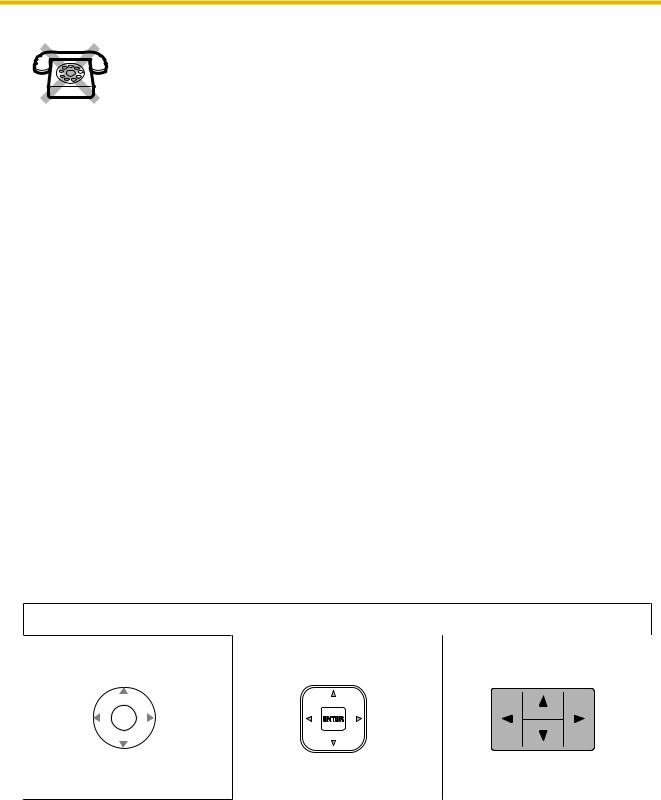
1.1.6 Before Operating the Telephones
If you use a single line telephone which does not have the "  " or "#" keys; it is not possible to access features that have "
" or "#" keys; it is not possible to access features that have "  " or "#" in their feature numbers.
" or "#" in their feature numbers.
 Tone
Tone
You will hear various tones, during or after an operation, for confirmation. Refer to "5.4.1 Tone" (Appendix).
 Display
Display
In this manual, "the display ..." refers to the display of a Panasonic telephone. If your telephone is not a Panasonic display telephone, the message will not be displayed. If you use a Panasonic display telephone, the display helps you confirm the settings. Some telephones also give you easy access to features. Messages are displayed according to the feature used. By pressing the corresponding button on the side or at the bottom of the display, or by pressing the Navigator Key, you can access various features. Furthermore, depending on the display telephone used, you can operate features or make calls using the displayed message. Refer to "1.4 Display Features".
Your Extension Number
If you use a Panasonic display proprietary telephone, you can check your own extension number on the display. Press the TRANSFER button or Soft (S1) button while on-hook.
ECO mode
If you use a KX-NT543, KX-NT546, or KX-NT560 IP-PT in ECO mode, the "ECO" icon is shown on the display during programming mode (refer to "3.1.4 Customizing the Buttons"). For more information, consult your dealer.
 Using a Navigator Key/Jog Dial/Volume Key
Using a Navigator Key/Jog Dial/Volume Key
The Navigator Key can be used for the display contrast and the volume control or you can search for desired items on the display. Press the Navigator Key/Volume Key or rotate the Jog Dial in the desired direction. The contrast or the volume level and the items will change as follows:
Navigator Key
Up |
|
Up |
|
Up |
(Level increases) |
(Level increases) |
|
(Level increases) |
|
Left ENTER Right |
Left |
Right |
Left |
Right |
Down |
|
Down |
|
Down |
(Level decreases) |
(Level decreases) |
|
(Level decreases) |
|
Document Version 2015-06 |
Operating Manual |
23 |
|
|
|

1.1.6 Before Operating the Telephones
Jog Dial |
Volume Key |
|
Up |
Up |
|
|
|
|
(Level increases) |
(Level increases) |
|
|
|
Left |
Right |
|
(counter-clockwise) |
(clockwise) |
|
Level decreases |
Level increases |
Down |
|
Down |
|
|
|
|
|
(Level decreases) |
(Level decreases) |
|
|
 Examples
Examples
The displays and the illustrations shown as examples are from a telephone connected to the KX-NS1000.
 Restrictions
Restrictions
Some features may be restricted at your extension depending on system programming and the type of telephone being used.
24 |
Operating Manual |
Document Version 2015-06 |
|
|
|

1.1.6 Before Operating the Telephones
 Icon Descriptions
Icon Descriptions
The following icons show you the feature availability, notes and action to use the features.
|
|
|
This feature cannot be used with a |
|
|
|
Seize a CO line (One of the |
||
|
|
|
|||||||
|
|
|
single line telephone. |
|
(CO) |
following). |
|||
|
|
|
|
|
OR |
||||
|
|
|
|
|
|
9 |
• Press the CO button. |
||
|
|
|
|
|
|
||||
|
|
|
|
|
|
|
|
OR |
• Dial automatic line access |
|
|
|
See "Programming" for Related |
|
|
||||
|
|
|
8 group no. |
number 9. |
|||||
|
|
|
Programming if necessary. |
• Dial CO line group access |
|||||
|
|
|
|
|
|
|
|
CO line |
|
|
|
|
|
|
|
|
|
|
number and CO line group |
|
|
|
|
|
|
|
|
|
number. |
|
|
|
|
|
|
|
|
||
|
|
|
Off-hook (One of the following). |
|
|
|
Press the Call button on the |
||
|
|
|
|||||||
|
|
|
• |
Lift the handset. |
|
|
|
Doorphone. |
|
|
|
|
• Press the SP-PHONE button. |
|
|
|
|
||
|
|
|
|
|
|
|
|||
|
|
|
• Press the MONITOR button. |
|
|
|
|
||
|
|
|
|
(To start talking, lift the |
|
|
|
|
|
|
|
|
• |
handset.) |
|
|
|
|
|
|
|
|
Press TALK button. |
|
|
|
|
||
On-hook (One of the following). |
Press the hookswitch lightly. |
•Hang up.
• Press the SP-PHONE button.
•Press the MONITOR button.
•Press CANCEL button.
|
Press the corresponding feature |
|
Talk or make an |
||
|
button on the proprietary telephone |
|
announcement. |
||
|
or KX-UT series SIP phone. |
|
|
|
|
|
|
|
|
||
desired no. |
Enter the required number. |
|
You will hear a busy, |
||
|
<Example> |
|
confirmation, dial, ring or |
||
|
account code |
|
ringback tone. |
||
|
|
B. Tone: Busy Tone |
|||
|
|
|
|||
|
Enter the account code. |
|
C. Tone: Confirmation Tone |
||
|
|
D. Tone: Dial Tone |
|||
|
|
|
|||
|
|
|
R. Tone: Ring Tone |
||
|
|
|
R. B. Tone: Ringback Tone |
||
|
|
|
|
||
extension no. |
Dial an extension number. |
outside |
Dial outside phone number. |
||
|
|
phone no. |
|
|
|
|
|
|
|
|
|
phone no. |
Dial the telephone number. |
dial key |
Press any dial key (0–9, |
|
, #). |
|
|||||
|
|
|
|
||
HOLD |
Press the HOLD button on your SIP |
REDIAL |
Press the REDIAL button on |
||
|
phone. |
|
your SIP phone. |
||
Document Version 2015-06 |
Operating Manual |
25 |
|
|
|

1.1.6 Before Operating the Telephones
 When You Use a Panasonic Proprietary Telephone or KX-UT Series SIP Phone
When You Use a Panasonic Proprietary Telephone or KX-UT Series SIP Phone
Panasonic proprietary telephones and KX-UT series SIP phones have useful feature buttons that simplify some operations. For details, refer to the "Location of Controls" or equivalent section in the documentation for your phone.
Customized Buttons
If the term is in parentheses like (Account) in this manual, it means a flexible button has been made into an "Account" button. For more information, refer to "3.1.4 Customizing the Buttons" when using a PT or PS, or "Customizing the Flexible Buttons" when using Web Maintenance Console.
Note
For KX-UT series SIP phone users:
•KX-UT113/KX-UT123: Customized buttons are not available.
•Other than KX-UT113/KX-UT123: The following buttons can be customized:
– |
Single-CO (S-CO) |
– |
Headset |
– |
DN |
– |
Wrap-up |
– |
One-touch Dialing |
– |
Call Park |
– |
Log-in/Log-out |
– Call Park (Automatic Park Zone) |
|
–DSS
Button |
Feature |
|
|
|
|
Loop-CO (L-CO) |
Used to access an idle CO line for making outside calls. |
|
Incoming outside calls from any CO line arrive at this button. |
||
|
||
|
|
|
|
Used to access an idle CO line in a specified CO line group for making |
|
Group-CO (G-CO) |
outside calls. |
|
Incoming calls from CO lines in the assigned CO line group arrive at this |
||
|
||
|
button. |
|
|
|
|
Single-CO (S-CO) |
Used to access a specified CO line for making or receiving outside calls. |
|
|
|
|
|
Used to access an extension with one touch. |
|
Direct Station Selection |
It is also possible to be changed to the other feature button. |
|
For KX-UT series SIP phones (except KX-UT113/KX-UT123), unlike a |
||
(DSS) |
||
One-Touch button, this type of button cannot be used to dial feature |
||
|
||
|
numbers. |
|
|
|
|
One-touch Dialing |
Used to access a desired party or system feature with one touch. |
|
|
|
|
Incoming Call Distribution |
Used to access a specified incoming call distribution group for making or |
|
Group (ICD Group) |
receiving calls. |
|
|
|
|
Message |
Used to leave a message waiting indication or call back the party who left |
|
the message waiting indication. |
||
|
||
|
|
|
Message for Another |
Used to have a Message button for another extension. |
|
Extension |
||
|
||
|
|
|
Call Forwarding (FWD)/Do |
|
|
Not Disturb (DND)—Both |
Used to forward all calls to a specified destination or refuse. |
|
calls |
|
|
|
|
|
FWD/DND—Outside calls |
Used to forward CO line calls to a specified destination or refuse. |
|
|
|
26 |
Operating Manual |
Document Version 2015-06 |
|
|
|
|
|
1.1.6 Before Operating the Telephones |
|
|
|
|
|
|
|
|
|
|
Button |
Feature |
|
|
|
|
|
|
FWD/DND—Intercom calls |
Used to forward intercom calls to a specified destination or refuse. |
|
|
|
|
|
|
Group FWD—Both calls |
Used to forward all the calls to your group to a specified destination. |
|
|
|
|
|
|
Group FWD—Outside calls |
Used to forward the CO line calls to your group to a specified destination. |
|
|
|
|
|
|
Group FWD—Intercom calls |
Used to forward the intercom calls to your group to a specified destination. |
|
|
|
|
|
|
Account |
Used to enter an account code. |
|
|
|
|
|
|
Conference |
Used to establish a multiple party conversation. |
|
|
|
|
|
|
Terminate |
Used to disconnect the current call and make another call without hanging |
|
|
up. |
|
|
|
|
|
|
|
|
|
|
|
External Feature Access |
Used to access special features offered by a host PBX or a telephone |
|
|
(EFA) |
company. |
|
|
|
|
|
|
Call Park |
Used to park or retrieve a call in a preset parking zone. |
|
|
|
|
|
|
|
Used to park a call in an idle parking zone automatically. |
|
|
Call Park (Automatic Park |
For KX-UT series SIP phones (except KX-UT113/KX-UT123), pressing |
|
|
this button selects an idle parking zone from among the Call Park (preset |
|
|
|
Zone) |
parking zone) buttons configured on the phone. Set both the Call Park |
|
|
|
(Automatic Park Zone) button and the Call Park (preset parking zone) |
|
|
|
button. |
|
|
|
|
|
|
Call Log |
Used to show the incoming call information. |
|
|
|
|
|
|
Call Log for ICD Group |
Used to have a Call Log button for incoming call distribution group. |
|
|
|
|
|
|
Log-in/Log-out |
Used to switch between the log-in and log-out mode. |
|
|
|
|
|
|
Log-in/Log-out of a specified |
Used to have a Log-in/Log-out button for another incoming call distribution |
|
|
group |
group. |
|
|
|
|
|
|
Log-in/Log-out for all groups |
Used to have a Log-in/Log-out button for all groups. |
|
|
|
|
|
|
Hurry-up |
Used to transfer the longest waiting call in the queue of an incoming call |
|
|
distribution group to the overflow destination. |
|
|
|
|
|
|
|
|
|
|
|
Wrap-up |
Used to switch the wrap-up status, Ready and Not Ready mode. |
|
|
|
|
|
|
System Alarm |
Used to confirm a PBX error. Also, pressing the System Alarm button |
|
|
displays the current One-look networking status. |
|
|
|
|
|
|
|
|
|
|
|
Time Service (Day/Night/ |
Used to switch the time service mode. |
|
|
Lunch/Break) |
|
|
|
|
|
|
|
|
|
|
|
Answer |
Used to answer an incoming call. |
|
|
|
|
|
|
Release |
Used to disconnect the line during or after a conversation or to complete |
|
|
a Call Transfer. |
|
|
|
|
|
|
|
|
|
|
|
Toll Restriction (TRS) |
Used to change the toll restriction level of other extension users |
|
|
temporarily. |
|
|
|
|
|
|
|
|
|
|
|
Calling Line Identification |
Used to switch between the CLIP and CLIR services. |
|
|
Restriction (CLIR) |
|
|
|
|
|
|
|
|
|
|
|
Connected Line Identification |
Used to switch between the COLP and COLR services. |
|
|
Restriction (COLR) |
|
|
|
|
|
|
|
|
|
|
Document Version 2015-06 |
Operating Manual |
27 |
|
|
|

1.1.6 Before Operating the Telephones
Button |
Feature |
|
|
|
|
Headset |
Used to talk using the headset. |
|
|
|
|
Time Service Switching Mode |
Used to switch the time service mode, Automatic or Manual. |
|
(Automatic/Manual) |
||
|
||
|
|
|
Two-way Record |
Used to record a conversation into your own mailbox. |
|
|
|
|
Two-way Transfer |
Used to record a conversation into the mailbox of a specific extension. |
|
|
|
|
One-touch Two-way Transfer |
Used to record a conversation into the mailbox of a specific extension with |
|
one touch. |
||
|
||
|
|
|
Live Call Screening (LCS) |
Used to monitor your own voice mailbox while an incoming caller is leaving |
|
a message and, if desired, intercept the call. |
||
|
||
|
|
|
|
Used to transfer a call to the mailbox of a specified extension. Also used |
|
Voice Mail Transfer |
to access the Unified Messaging system or the voice mail features of a |
|
|
VPS with one touch. |
|
|
|
|
Network Direct Station |
Used to access an extension connected to other PBXs in the network with |
|
Selection (NDSS) |
one touch. |
|
|
|
|
CTI |
Used to access CTI features. |
|
|
|
|
Check-in |
Used to switch the room status of extensions from Check-out to Check-in. |
|
|
|
|
Check-out |
Used to switch the room status of extensions from Check-in to Check-out. |
|
|
|
|
Cleaned-up |
Used to switch the room status of extensions between Ready and Not |
|
Ready. |
||
|
||
|
|
|
Primary Directory Number |
Used to make and receive both outside and intercom calls. |
|
(PDN) |
||
|
||
|
|
|
Secondary Directory Number |
Used to show the current status of another extension, call the extension, |
|
(SDN) |
and pick up or transfer calls to it. |
|
|
|
|
Directory Number (DN) |
|
|
(KX-UT series SIP phones |
Used to make intercom or outside calls. |
|
[except KX-UT113/ |
||
|
||
KX-UT123] only) |
|
|
|
|
28 |
Operating Manual |
Document Version 2015-06 |
|
|
|
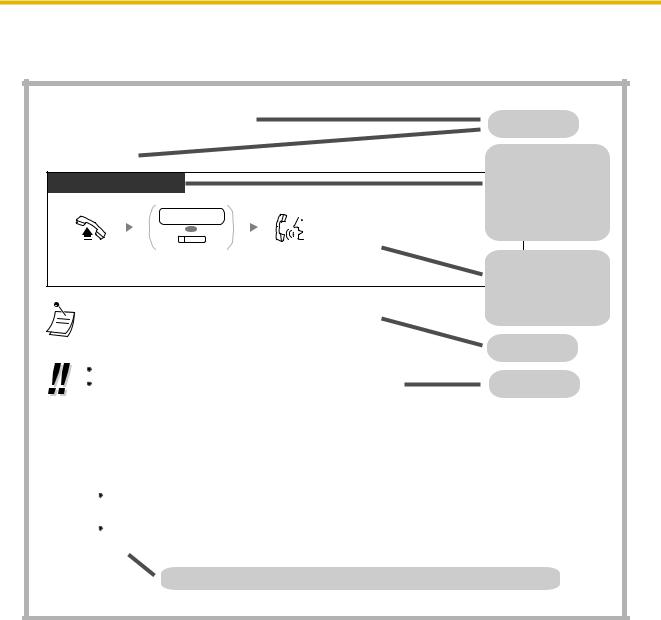
1.1.6 Before Operating the Telephones
 How to Follow the Steps
How to Follow the Steps
An example of system operation is shown below.
 Calling Another Extension
Calling Another Extension
Intercom Call
PT/SLT/PS/SIP Extn.
extension no.
OR
|
(DSS) |
|
Off-hook. |
Dial extension number |
Talk. |
|
or press DSS. |
|
 The DSS button light shows the current status as follows:
The DSS button light shows the current status as follows:
Off: The extension is idle.
Red on: Your or another extension is using the line.
Feature title
Telephone types
The abbreviations of telephone types are explained in "Telephone types in procedures" below.
Operation steps
The description of the icons are explained on "Icon Descriptions".
Conditions
To call using a directory, refer to "1.4.3 Directories". |
|
For quick operation |
Hints |
If you are an operator or dial some extensions frequently, DSS buttons are useful. |
|
 Hands-free Operation
Hands-free Operation
You can make an intercom call and have a conversation in hands-free mode using the SP-
PHONE button (refer to "1.3.32 Hands-free Operation").
 Customizing Your Phone
Customizing Your Phone
3.1.2 Personal Programming—Preferred Line Assignment—Outgoing
Select the seized line when going off-hook.
3.1.4 Customizing the Buttons
Create or edit a Direct Station Selection (DSS) button.
Programming References: The related or required programming is noted.
Telephone types in procedures
The following abbreviations are displayed at the top left of each procedure and indicate which types of telephones support the operation. However, in some cases a specific model number is given instead (e.g., KX-UT136, KX-UT series).
Abbreviation |
Telephone Type |
|
|
|
|
PT |
Proprietary Telephone (e.g., KX-NT300 series, KX-NT500 series, |
|
|
|
KX-NT265, KX-T7700 series) |
|
|
|
|
DPT |
Digital Proprietary Telephone (e.g., KX-T7600 series, KX-DT300 series, |
|
|
KX-DT500 series) |
|
|
|
|
Display PT |
Proprietary Telephone with a Display (e.g. KX-NT346, KX-NT546, |
|
|
KX-DT346, KX-DT546, KX-T7636) |
|
|
|
PS |
Portable Station (e.g., KX-TD7696, KX-WT125) |
|
|
|
|
Document Version 2015-06 |
Operating Manual |
29 |
|
|
|

1.1.6 Before Operating the Telephones
Abbreviation |
Telephone Type |
|
|
SIP Extn. |
SIP phone (e.g., KX-UT series SIP phones, Third party SIP phones, P-SIP) |
|
|
SLT |
Single Line Telephone |
|
|
30 |
Operating Manual |
Document Version 2015-06 |
|
|
|
